Export To Excel in WPF TreeGrid (SfTreeGrid)
27 Feb 202524 minutes to read
SfTreeGrid provides support to export the data to Excel file. This also provides support to export the headers and stacked headers. This maintains the sorting and filtering processes when exporting.
The following assemblies should be added for exporting a tree grid to Excel:-
- Syncfusion.SfGridConverter.WPF
- Syncfusion.XlsIO.Base
- Syncfusion.XlsIO.Wpf
For NuGet package, have to install Syncfusion.DataGridExcelExport.WPF package. For more details refer this UG link.
You can export the tree grid to Excel by using the ExportToExcel extension method present in Syncfusion.UI.Xaml.TreeGrid.Converter namespace.
using Syncfusion.UI.Xaml.TreeGrid.Converter;
var options = new TreeGridExcelExportingOptions();
options.ExcelVersion = ExcelVersion.Excel2013;
var excelEngine = treeGrid.ExportToExcel(options);
var workBook = excelEngine.Excel.Workbooks[0];
workBook.SaveAs("Sample.xlsx");NOTE
SfTreeGrid exports the data to Excel using XlsIO. You can refer to the XlsIO documentation for manipulating the exported work sheets.
Export options
The exporting operation can be customized by passing TreeGridExcelExportingOptions instance as an argument to the ExportToExcel method.
Change export mode
By default, the actual value will only be exported to Excel. To export the display text, set the TreeGridExportMode property as Text.
var options = new TreeGridExcelExportingOptions();
options.ExcelVersion = ExcelVersion.Excel2013;
options.TreeGridExportMode = TreeGridExportMode.Text;
var excelEngine = treeGrid.ExportToExcel(options);
var workBook = excelEngine.Excel.Workbooks[0];
workBook.SaveAs("Sample.xlsx");Export without outlines
By default, all the children in the tree grid will be exported in expanded state. You can disable the outlines in Excel by setting the AllowOutliningGroups property to false in TreeGridExcelExportingOptions class.
var options = new TreeGridExcelExportingOptions();
options.ExcelVersion = ExcelVersion.Excel2013;
options.AllowOutliningGroups = false;
var excelEngine = treeGrid.ExportToExcel(options);
var workBook = excelEngine.Excel.Workbooks[0];
workBook.SaveAs("Sample.xlsx");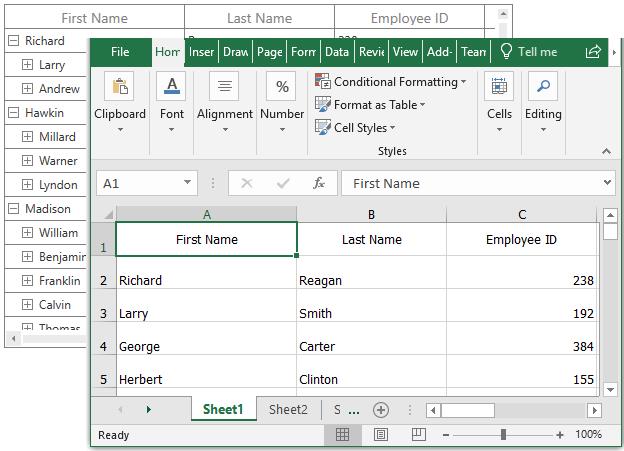
Exclude columns when exporting
By default, all the columns (including hidden columns) in the tree grid will be exported to Excel. To exclude some columns, use ExcludeColumns field in TreeGridExcelExportingOptions class.
var options = new TreeGridExcelExportingOptions();
options.ExcelVersion = ExcelVersion.Excel2013;
options.ExcludeColumns.Add("FirstName");
options.ExcludeColumns.Add("LastName");
var excelEngine = treeGrid.ExportToExcel(options);
var workBook = excelEngine.Excel.Workbooks[0];
workBook.SaveAs("Sample.xlsx");Here, the columns having FirstName and LastName as MappingName are excluded when exporting.
Excel version
When exporting to Excel, you can specify the Excel version by using the ExcelVersion property.
var options = new TreeGridExcelExportingOptions();
options.ExcelVersion = ExcelVersion.Excel2013;
var excelEngine = treeGrid.ExportToExcel(options);
var workBook = excelEngine.Excel.Workbooks[0];
workBook.SaveAs("Sample.xlsx");Export stacked headers to Excel
You can export the stacked headers to Excel by setting the ExportStackedHeaders property to true.
var options = new TreeGridExcelExportingOptions();
options.ExcelVersion = ExcelVersion.Excel2013;
options.ExportStackedHeaders = true;
var excelEngine = treeGrid.ExportToExcel(options);
var workBook = excelEngine.Excel.Workbooks[0];
workBook.SaveAs("Sample.xlsx");Export hyper-link to Excel
You can export the hyper-link to Excel by setting the CanExportHyperLink property to true.
var options =new TreeGridExcelExportingOptions();
options.ExcelVersion = ExcelVersion.Excel2013;
options.CanExportHyperLink = true;
var excelEngine = treeGrid.ExportToExcel(options);
var workBook = excelEngine.Excel.Workbooks[0];
workBook.SaveAs("Sample.xlsx");The default value of the CanExportHyperLink property is true.
Export column width to Excel
You can export the columns with its actual width by setting the ExportColumnWidth property to true.
var options =new TreeGridExcelExportingOptions();
options.ExcelVersion = ExcelVersion.Excel2013;
options.ExportColumnWidth = true;
var excelEngine = treeGrid.ExportToExcel(options);
var workBook = excelEngine.Excel.Workbooks[0];
workBook.SaveAs("Sample.xlsx");The default value of the ExportColumnWidth property is true.
Export with customized row height
You can export the tree grid to Excel with customized row height by using the DefaultRowHeight property.
var options =new TreeGridExcelExportingOptions();
options.ExcelVersion = ExcelVersion.Excel2013;
options.DefaultRowHeight = 60;
var excelEngine = treeGrid.ExportToExcel(options);
var workBook = excelEngine.Excel.Workbooks[0];
workBook.SaveAs("Sample1.xlsx");Export without grid lines
You can export the tree grid to Excel without grid lines by setting the IsGridLinesVisible property to false.
var options =new TreeGridExcelExportingOptions();
options.ExcelVersion = ExcelVersion.Excel2013;
options.IsGridLinesVisible = true;
var excelEngine = treeGrid.ExportToExcel(options);
var workBook = excelEngine.Excel.Workbooks[0];
workBook.SaveAs("Sample.xlsx");The default value of the IsGridLinesVisible property is true.
Export with indent column
You can export the tree grid to Excel with indent column to denote the nodes level by setting the AllowIndentColumn property to true.
var options =new TreeGridExcelExportingOptions();
options.ExcelVersion = ExcelVersion.Excel2013;
options.AllowIndentColumn = true;
var excelEngine = treeGrid.ExportToExcel(options);
var workBook = excelEngine.Excel.Workbooks[0];
workBook.SaveAs("Sample1.xlsx");The default value of the AllowIndentColumn property is false.
Change the node expand state in Excel
You can change the node expanding state in Excel by using the NodeExpandMode property.
var options =new TreeGridExcelExportingOptions();
options.ExcelVersion = ExcelVersion.Excel2013;
options.NodeExpandMode = NodeExpandMode.CollapseAll;
var excelEngine = treeGrid.ExportToExcel(options);
var workBook = excelEngine.Excel.Workbooks[0];
workBook.SaveAs("Sample.xlsx");Change start row and column index while exporting
You can export the data to a specified row and column index in the worksheet, by setting the ExcelStartRowIndex and ExcelStartColumnIndex properties.
var options = new TreeGridExcelExportingOptions();
options.ExcelVersion = ExcelVersion.Excel2013;
options.ExcelStartColumnIndex = 3;
options.ExcelStartRowIndex = 3;
var excelEngine = treeGrid.ExportToExcel(options);
var workBook = excelEngine.Excel.Workbooks[0];
workBook.SaveAs("Sample.xlsx");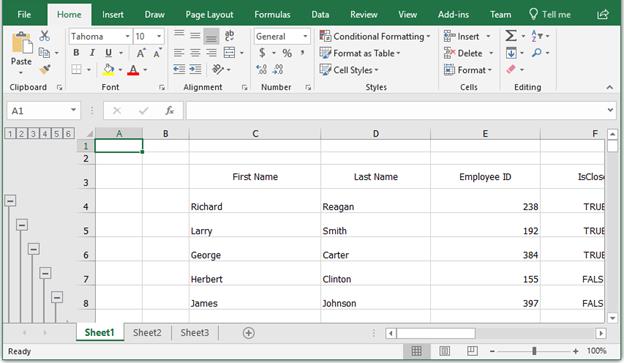
Save options
Save Excel directory to file
After exporting to Excel, you can save the exported workbook directly to the file system using the SaveAs method.
var options = new TreeGridExcelExportingOptions();
options.ExcelVersion = ExcelVersion.Excel2013;
var excelEngine = treeGrid.ExportToExcel(options);
var workBook = excelEngine.Excel.Workbooks[0];
workBook.SaveAs("Sample.xlsx");Save Excel to stream
After exporting to Excel, you can save the exported workbook to stream using the SaveAs method.
var options = new TreeGridExcelExportingOptions();
options.ExcelVersion = ExcelVersion.Excel2013;
var excelEngine = treeGrid.ExportToExcel(options);
var workBook = excelEngine.Excel.Workbooks[0];
FileStream fileStream = new FileStream("Output.xlsx", FileMode.Create);
workBook.SaveAs(fileStream);You can refer to the XlsIO documentation.
Save Excel using File dialog
After exporting to Excel, you can save the exported workbook by opening the FileDialog.
var options = new TreeGridExcelExportingOptions();
options.ExcelVersion = ExcelVersion.Excel2013;
var excelEngine = treeGrid.ExportToExcel(options);
var workBook = excelEngine.Excel.Workbooks[0];
SaveFileDialog sfd = new SaveFileDialog
{
FilterIndex = 2,
Filter = "Excel 97 to 2003 Files(*.xls)|*.xls|Excel 2007 to 2010 Files(*.xlsx)|*.xlsx|Excel 2013 File(*.xlsx)|*.xlsx"
};
if (sfd.ShowDialog() == true)
{
using (Stream stream = sfd.OpenFile())
{
if (sfd.FilterIndex == 1)
workBook.Version = ExcelVersion.Excel97to2003;
else if (sfd.FilterIndex == 2)
workBook.Version = ExcelVersion.Excel2010;
else
workBook.Version = ExcelVersion.Excel2013;
workBook.SaveAs(stream);
}
//Message box confirmation to view the created workbook.
if (MessageBox.Show("Do you want to view the workbook?", "Workbook has been created",
MessageBoxButton.YesNo, MessageBoxImage.Information) == MessageBoxResult.Yes)
{
//Launching the Excel file using the default Application.[MS Excel Or Free ExcelViewer]
System.Diagnostics.Process.Start(sfd.FileName);
}
}
}Open exported Excel without saving in disk
You can open the exported workbook without saving by using the SfSpreadsheet control.
var options = new TreeGridExcelExportingOptions();
options.ExcelVersion = ExcelVersion.Excel2013;
var excelEngine = treeGrid.ExportToExcel(options);
var workBook = excelEngine.Excel.Workbooks[0];
Window1 window1 = new Window1();
SfSpreadsheet spreadsheet = new SfSpreadsheet();
spreadsheet.Open(workBook);
window1.Content = spreadsheet;
window1.Show();
Export to HTML
You can save the exported workbook as HTML by using the SaveAsHtml method.
var options = new TreeGridExcelExportingOptions();
options.ExcelVersion = ExcelVersion.Excel2013;
options.AllowOutliningGroups = false;
var excelEngine = treeGrid.ExportToExcel(options);
var workBook = excelEngine.Excel.Workbooks[0];
workBook.SaveAsHtml("Sample.html", HtmlSaveOptions.Default);It is also possible to save the worksheet as HTML by using the SaveAsHtml method. You can refer toXlsIO documentation.
Export to mail
You can export the tree grid to mail by converting to Excel and save the exported worksheet as HTML. Then the exported HTML contents should be embedded in the mail body.
var options = new TreeGridExcelExportingOptions();
options.ExcelVersion = ExcelVersion.Excel2013;
var excelEngine = treeGrid.ExportToExcel(options);
var workBook = excelEngine.Excel.Workbooks[0];
workBook.Worksheets[0].UsedRange.BorderInside(ExcelLineStyle.Thick, ExcelKnownColors.Black);
workBook.Worksheets[0].UsedRange.BorderAround(ExcelLineStyle.Thick, ExcelKnownColors.Black);
workBook.Worksheets[0].SaveAsHtml("test.htm", Syncfusion.XlsIO.Implementation.HtmlSaveOptions.Default);
System.Net.Mail.MailMessage myMessage = new System.Net.Mail.MailMessage();
myMessage.To.Add("[email protected]");
myMessage.From = new MailAddress("[email protected]");
myMessage.Priority = MailPriority.High;
myMessage.Subject = "Order Details";
myMessage.IsBodyHtml = true;
myMessage.Body = new StreamReader("test.htm").ReadToEnd();
SmtpClient client = new SmtpClient("smtp.office365.com", 587);
client.EnableSsl = true;
client.UseDefaultCredentials = false;
client.Credentials = new NetworkCredential("[email protected]", "test");
int count = 0;
while (count < 3)
{
try
{
client.Send(myMessage);
count = 3;
}
catch (Exception ex)
{
Console.WriteLine(ex.Message);
Console.WriteLine(String.Format("Sending Mail Attemp - {0}", count.ToString()));
Thread.Sleep(60000);
count++;
}
}
Console.WriteLine("Mail has been sent...");
}Export to XML
You can save the exported workbook as Xml file using the SaveAsXml method.
var options = new TreeGridExcelExportingOptions();
options.ExcelVersion = ExcelVersion.Excel2013;
var excelEngine = treeGrid.ExportToExcel(options);
var workBook = excelEngine.Excel.Workbooks[0];
workBook.SaveAsXml("Sample.xml", ExcelXmlSaveType.MSExcel);Export to CSV
You can save the exported workbook as CSV using the SaveAs method.
var options = new TreeGridExcelExportingOptions();
options.ExcelVersion = ExcelVersion.Excel2013;
var excelEngine = treeGrid.ExportToExcel(options);
var workBook = excelEngine.Excel.Workbooks[0];
workBook.SaveAs("Sample.csv", ",");Similarly, you can also save the exported worksheet to CSV. Refer to the XlsIO documentation.
Customize row height and column width
After exporting the data to Excel, you can set different row heights and column widths for the columns. You can refer to here for more information.
var options = new TreeGridExcelExportingOptions();
options.ExcelVersion = ExcelVersion.Excel2013;
var excelEngine = treeGrid.ExportToExcel(options);
var workBook = excelEngine.Excel.Workbooks[0];
workBook.Worksheets[0].SetRowHeight(2, 50);
workBook.Worksheets[0].SetColumnWidth(2, 50);
workBook.SaveAs("Sample.xlsx");Customize Cell appearance when exporting
You can customize the cells by setting the ExportingEventHandler in TreeGridExcelExportingOptions.
Cell styling cells based on cell type in Excel
You can customize the cell styles based on the cell type by using the ExportingEventHandler.
var options = new TreeGridExcelExportingOptions();
options.ExcelVersion = ExcelVersion.Excel2013;
options.ExportingEventHandler = ExportingHandler;
var excelEngine = treeGrid.ExportToExcel(options);
var workBook = excelEngine.Excel.Workbooks[0];
workBook.SaveAs("Sample.xlsx");
private static void ExportingHandler(object sender, TreeGridExcelExportingEventArgs e)
{
if (e.CellType == TreeGridCellType.HeaderCell)
{
e.Style.ColorIndex = ExcelKnownColors.Pink;
e.Handled = true;
}
else if (e.CellType == TreeGridCellType.RecordCell)
{
e.Style.ColorIndex = ExcelKnownColors.Sky_blue;
e.Handled = true;
}
}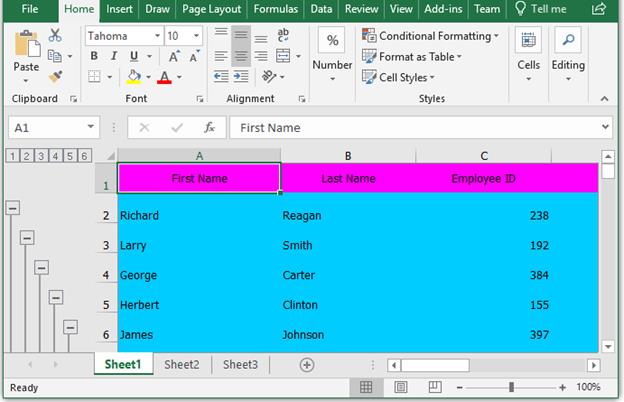
Customize the exporting content to Excel
You can customize the cell values when exporting to Excel by using the CellsExportingEventHandler in TreeGridExcelExportingOptions.
var options = new TreeGridExcelExportingOptions();
options.ExcelVersion = ExcelVersion.Excel2013;
options.CellsExportingEventHandler = CellExportingHandler;
var excelEngine = treeGrid.ExportToExcel(options);
var workBook = excelEngine.Excel.Workbooks[0];
workBook.SaveAs("Sample.xlsx");
private static void CellExportingHandler(object sender, TreeGridCellExcelExportingEventArgs e)
{
// Based on the column mapping name and the cell type, we can change the cell
//values while exporting to excel.
if (e.CellType == TreeGridCellType.RecordCell && e.ColumnName == "IsClosed")
{
//if the cell value is True, "Y" will be displayed else "N" will be displayed.
if (e.CellValue.Equals(true))
e.Range.Cells[0].Value = "Y";
else
e.Range.Cells[0].Value = "N";
e.Handled = true;
}
}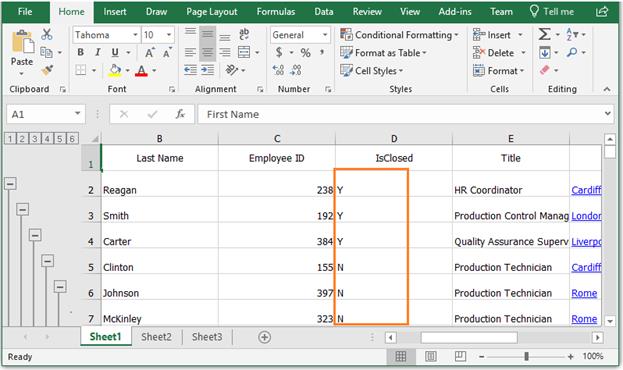
Here, the cell values changed for the IsClosed column are based on the custom condition.
Change row style in Excel based on data
You can customize the rows based on the record values by using the CellsExportingEventHandler.
var options = new TreeGridExcelExportingOptions();
options.ExcelVersion = ExcelVersion.Excel2013;
options.CellsExportingEventHandler = CellExportingHandler;
var excelEngine = treeGrid.ExportToExcel(options);
var workBook = excelEngine.Excel.Workbooks[0];
workBook.SaveAs("Sample.xlsx");
private static void CellExportingHandler(object sender, TreeGridCellExcelExportingEventArgs e)
{
if ((e.Node==null))
return;
var record = e.Node as EmployeeInfo;
if (record.City == "NewYork")
{
e.Range.CellStyle.ColorIndex = ExcelKnownColors.Green;
e.Range.CellStyle.Font.Color = ExcelKnownColors.White;
}
}
Customize the cells based on column name
You can customize the cells based on the GridCellExcelExportingEventArgs.ColumnName property in CellsExportingEventHandler.
var options = new TreeGridExcelExportingOptions();
options.ExcelVersion = ExcelVersion.Excel2013;
options.AllowOutliningGroups = false;
options.CellsExportingEventHandler = CellExportingHandler;
var excelEngine = treeGrid.ExportToExcel(options);
var workBook = excelEngine.Excel.Workbooks[0];
workBook.SaveAs("Sample.xlsx");
private static void CellExportingHandler(object sender, TreeGridCellExcelExportingEventArgs e)
{
if (e.ColumnName != "ID")
return;
e.Range.CellStyle.Font.Size = 12;
e.Range.CellStyle.Font.Color = ExcelKnownColors.Pink;
e.Range.CellStyle.Font.FontName = "Segoe UI";
}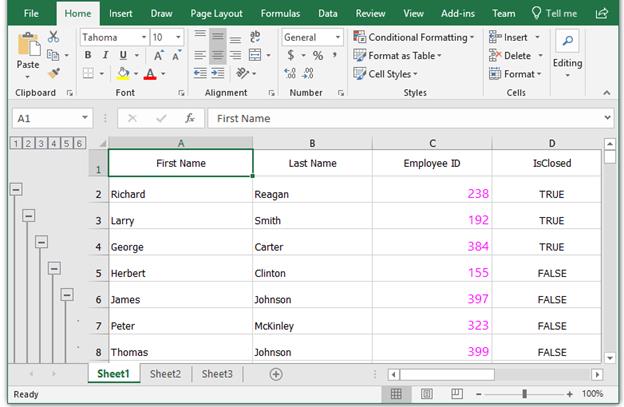
Customize exported workbook and worksheet
The tree grid can be exported to Excel using XlsIO. You can refer to the XlsIO documentation for manipulating the workbooks and sheets after exporting.
Set borders
You can set the borders to Excel cells by directly accessing worksheet after exporting the data.
var options = new TreeGridExcelExportingOptions();
options.ExcelVersion = ExcelVersion.Excel2013;
var excelEngine = treeGrid.ExportToExcel(options);
var workBook = excelEngine.Excel.Workbooks[0];
workBook.Worksheets[0].UsedRange.BorderInside(ExcelLineStyle.Dash_dot, ExcelKnownColors.Black);
workBook.Worksheets[0].UsedRange.BorderAround(ExcelLineStyle.Dash_dot, ExcelKnownColors.Black);
workBook.SaveAs("Sample.xlsx");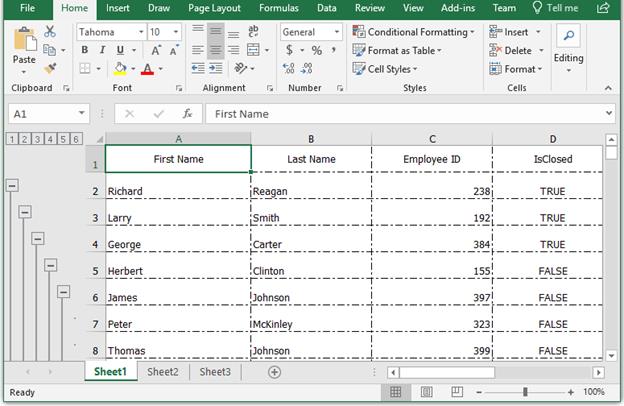
Enable filters
You can show filters in the exported worksheet by enabling filter for the exported range.
var options = new TreeGridExcelExportingOptions();
options.ExcelVersion = ExcelVersion.Excel2013;
var excelEngine = treeGrid.ExportToExcel(options);
var workBook = excelEngine.Excel.Workbooks[0];
workBook.Worksheets[0].AutoFilters.FilterRange = workBook.Worksheets[0].UsedRange;
workBook.SaveAs("Sample.xlsx");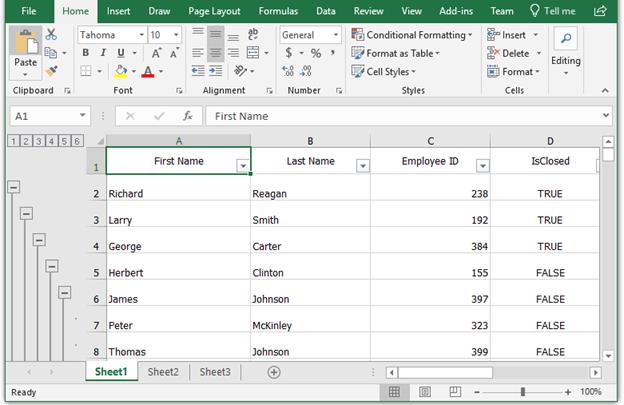
When using the stacked headers, you can specify the range based on the stacked headers count.
var options = new TreeGridExcelExportingOptions();
options.ExcelVersion = ExcelVersion.Excel2013;
var excelEngine = treeGrid.ExportToExcel(options);
var workBook = excelEngine.Excel.Workbooks[0];
var range = "A" + (treeGrid.StackedHeaderRows.Count + 1).ToString() + ":" + workBook.Worksheets[0].UsedRange.End.AddressLocal;
excelEngine.Excel.Workbooks[0].Worksheets[0].AutoFilters.FilterRange = workBook.Worksheets[0].Range[range];
workBook.SaveAs("Sample.xlsx");You can refer to the XlsIO documentation.
Customize the range of cells
You can customize the range of cells after exporting to Excel by directly manipulating the worksheet.
var options = new TreeGridExcelExportingOptions();
options.ExcelVersion = ExcelVersion.Excel2013;
var excelEngine = treeGrid.ExportToExcel(options);
var workBook = excelEngine.Excel.Workbooks[0];
workBook.Worksheets[0].Range["A2:A6"].CellStyle.Color = System.Drawing.Color.LightSlateGray;
workBook.Worksheets[0].Range["A2:A6"].CellStyle.Font.Color = ExcelKnownColors.White;
workBook.SaveAs("Sample.xlsx");
Performance
Using the ExcelExportingOptions.CellsExportingEventHandler and changing the settings for each cell will consume more memory and time. So, avoid using the CellsExportingEventHandler and instead of this, you can do the required settings in the exported sheet.
Format column without using CellsExportingEventHandler
You can perform cell level customizations such as row-level styling, formatting a particular column in the exported worksheet.
In the following code snippet, NumberFormat for Employee ID column is changed in the exported sheet after exporting without using the CellsExportingEventHandler.
Reference:
https://help.syncfusion.com/file-formats/xlsio/working-with-cell-or-range-formatting
var options = new TreeGridExcelExportingOptions();
options.TreeGridExportMode = TreeGridExportMode.Value;
options.ExcelVersion = ExcelVersion.Excel2013;
var excelEngine = treeGrid.ExportToExcel(options);
IWorkbook workBook = excelEngine.Excel.Workbooks[0];
workBook.ActiveSheet.Columns[2].NumberFormat = "0.0";
workBook.SaveAs("Sample.xlsx");
Alternate row styling without using CellsExportingEventHandler
In the following code snippet, the background color of the rows in Excel is changed based on the row index using conditional formatting for better performance.
var options = new TreeGridExcelExportingOptions();
options.TreeGridExportMode = TreeGridExportMode.Value;
options.ExcelVersion = ExcelVersion.Excel2013;
var excelEngine = treeGrid.ExportToExcel(options);
IWorkbook workBook = excelEngine.Excel.Workbooks[0];
IConditionalFormats condition = workBook.ActiveSheet.Range[2, 1, this.treeGrid.View.Nodes.Count + 1, this.treeGrid.Columns.Count].ConditionalFormats;
IConditionalFormat condition1 = condition.AddCondition();
condition1.FormatType = ExcelCFType.Formula;
condition1.FirstFormula = "MOD(ROW(),2)=0";
condition1.BackColorRGB = System.Drawing.Color.Pink;
IConditionalFormat condition2 = condition.AddCondition();
condition2.FormatType = ExcelCFType.Formula;
condition2.FirstFormula = "MOD(ROW(),2)=1";
condition2.BackColorRGB = System.Drawing.Color.LightGray;
workBook.SaveAs("Sample.xlsx");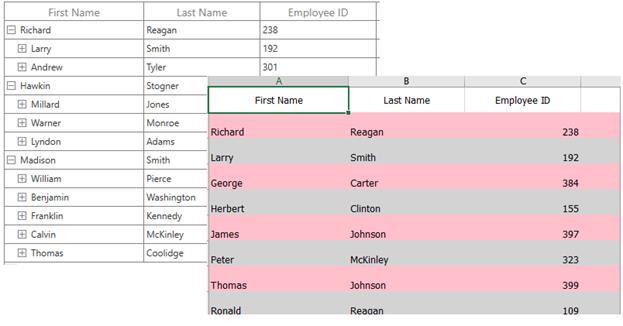
How to
Export multiple tree grids to single Excel sheet
You can export multiple tree grids to single Excel sheet by merging one tree grid worksheet into another using the Worksheet.UsedRange.CopyTo method.
var options = new TreeGridExcelExportingOptions();
options.ExcelVersion = ExcelVersion.Excel2010;
var excelEngine = treeGrid.ExportToExcel(options);
var workBook1 = excelEngine.Excel.Workbooks[0];
var worksheet1 = workBook1.Worksheets[0];
excelEngine = treeGrid1.ExportToExcel(options);
var workBook2 = excelEngine.Excel.Workbooks[0];
var worksheet2 = workBook2.Worksheets[0];
var columnCount = this.treeGrid1.Columns.Count;
//Merge the One TreeGrid WorkSheet into the other TreeGrid WorkSheet
worksheet2.UsedRange.CopyTo(worksheet1[1, columnCount + 1]);
workBook1.SaveAs("sample.xlsx");Export the tree grid that is not loaded in view
You can export the tree grid that is not loaded in view by calling the ApplyTemplate() method before exporting.
var options = new TreeGridExcelExportingOptions();
options.ExcelVersion = ExcelVersion.Excel2010;
treeGrid1.ApplyTemplate();
var excelEngine = treeGrid1.ExportToExcel(options);
var workBook1 = excelEngine.Excel.Workbooks[0];
var worksheet1 = workBook1.Worksheets[0];
workBook1.SaveAs("sample.xlsx");Export parent and expanded child nodes
By default, all the tree grid nodes will be exported when calling the ExportToExcel method. You can export only the parent and expanded child nodes by overriding theExportNodesToExcel method of TreeGridToExcelConverter class,
var options = new TreeGridExcelExportingOptions();
options.ExcelVersion = ExcelVersion.Excel2013;
var excelEngine = treeGrid.ExportToExcel(options, true);
var workBook = excelEngine.Excel.Workbooks[0];
workBook.SaveAs("Sample.xlsx");
protected override void ExportNodesToExcel(SfTreeGrid treeGrid, TreeNodes nodes, IWorksheet sheet, TreeGridExcelExportingOptions excelExportingOptions)
{
if (!_excludeNonExpandedNodes)
{
base.ExportNodesToExcel(treeGrid, nodes, sheet, excelExportingOptions);
}
else
{
for (int i = 0; i < nodes.Count; i++)
{
TreeNode node = nodes[i];
ExportNodeToExcel(treeGrid, node, sheet, excelExportingOptions);
if (node.IsExpanded && node.HasChildNodes)
{
node.PopulateChildNodes();
ExportNodesToExcel(treeGrid, node.ChildNodes, sheet, excelExportingOptions);
}
}
}
}You can download the sample here.
NOTE
You can refer to our WPF TreeGrid feature tour page for its groundbreaking feature representations. You can also explore our WPF TreeGrid example to know how to render and configure the treegrid.